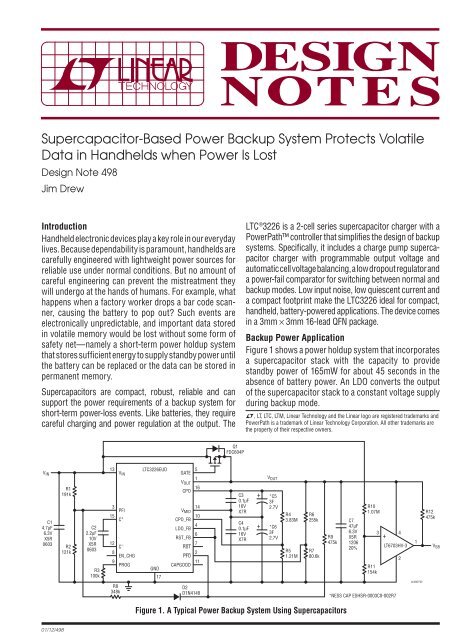201303.pdf 36567KB Mar 22 2013 09:11:22 PM
201303.pdf 36567KB Mar 22 2013 09:11:22 PM
201303.pdf 36567KB Mar 22 2013 09:11:22 PM
You also want an ePaper? Increase the reach of your titles
YUMPU automatically turns print PDFs into web optimized ePapers that Google loves.
Supercapacitor-Based Power Backup System Protects Volatile<br />
Data in Handhelds when Power Is Lost<br />
Design Note 498<br />
Jim Drew<br />
Introduction<br />
Handheld electronic devices play a key role in our everyday<br />
lives. Because dependability is paramount, handhelds are<br />
carefully engineered with lightweight power sources for<br />
reliable use under normal conditions. But no amount of<br />
careful engineering can prevent the mistreatment they<br />
will undergo at the hands of humans. For example, what<br />
happens when a factory worker drops a bar code scanner,<br />
causing the battery to pop out? Such events are<br />
electronically unpredictable, and important data stored<br />
in volatile memory would be lost without some form of<br />
safety net—namely a short-term power holdup system<br />
that stores suffi cient energy to supply standby power until<br />
the battery can be replaced or the data can be stored in<br />
permanent memory.<br />
Supercapacitors are compact, robust, reliable and can<br />
support the power requirements of a backup system for<br />
short-term power-loss events. Like batteries, they require<br />
careful charging and power regulation at the output. The<br />
LTC ® 3<strong>22</strong>6 is a 2-cell series supercapacitor charger with a<br />
PowerPath controller that simplifies the design of backup<br />
systems. Specifically, it includes a charge pump supercapacitor<br />
charger with programmable output voltage and<br />
automatic cell voltage balancing, a low dropout regulator and<br />
a power-fail comparator for switching between normal and<br />
backup modes. Low input noise, low quiescent current and<br />
a compact footprint make the LTC3<strong>22</strong>6 ideal for compact,<br />
handheld, battery-powered applications. The device comes<br />
in a 3mm × 3mm 16-lead QFN package.<br />
Backup Power Application<br />
Figure 1 shows a power holdup system that incorporates<br />
a supercapacitor stack with the capacity to provide<br />
standby power of 165mW for about 45 seconds in the<br />
absence of battery power. An LDO converts the output<br />
of the supercapacitor stack to a constant voltage supply<br />
during backup mode.<br />
L, LT, LTC, LTM, Linear Technology and the Linear logo are registered trademarks and<br />
PowerPath is a trademark of Linear Technology Corporation. All other trademarks are<br />
the property of their respective owners.<br />
Q1<br />
FDC604P<br />
V IN<br />
13<br />
V IN<br />
LTC3<strong>22</strong>6EUD<br />
GATE<br />
5<br />
1<br />
V OUT<br />
V OUT<br />
V SB<br />
C1<br />
4.7μF<br />
6.3V<br />
X5R<br />
0603<br />
R1<br />
191k<br />
R2<br />
121k<br />
C2<br />
2.2μF<br />
10V<br />
X5R<br />
0603<br />
R3<br />
100k<br />
3<br />
PFI<br />
15<br />
C +<br />
12<br />
C –<br />
8<br />
EN_CHG<br />
9<br />
PROG<br />
R8<br />
348k<br />
GND<br />
17<br />
CPO<br />
16<br />
14<br />
V MID<br />
10<br />
CPO_FB<br />
4<br />
LDO_FB<br />
6<br />
RST_FB<br />
7<br />
RST<br />
2<br />
PFO<br />
<strong>11</strong><br />
CAPGOOD<br />
D2<br />
D1N4148<br />
C3<br />
0.1μF<br />
16V<br />
X7R<br />
C4<br />
0.1μF<br />
16V<br />
X7R<br />
+<br />
+<br />
*C5<br />
3F<br />
2.7V<br />
*C6<br />
3F<br />
2.7V<br />
R4<br />
3.83M<br />
R5<br />
1.21M<br />
R6<br />
255k<br />
R7<br />
80.6k<br />
R9<br />
475k<br />
C7<br />
47μF<br />
6.3V<br />
X5R<br />
1206<br />
20%<br />
R10<br />
1.07M<br />
*NESS CAP ESHSR-0003C0-002R7<br />
3<br />
R<strong>11</strong><br />
154k<br />
+<br />
4<br />
LT6703HV-3<br />
2<br />
1<br />
dn498 F02<br />
R12<br />
475k<br />
Figure 1. A Typical Power Backup System Using Supercapacitors<br />
01/12/498






![[270].pdf 37407KB Sep 02 2010 09:55:57 AM - ElectronicsAndBooks](https://img.yumpu.com/50350834/1/185x260/270pdf-37407kb-sep-02-2010-095557-am-electronicsandbooks.jpg?quality=85)
![draaien, A Viruly 1935 OCR c20130324 [320]. - ElectronicsAndBooks](https://img.yumpu.com/49957773/1/190x252/draaien-a-viruly-1935-ocr-c20130324-320-electronicsandbooks.jpg?quality=85)



![20051110 c20051031 [105].pdf 35001KB Feb 18 2009 08:46:32 PM](https://img.yumpu.com/48687202/1/190x253/20051110-c20051031-105pdf-35001kb-feb-18-2009-084632-pm.jpg?quality=85)





